When planning this part of our trip, Chad and I wanted a short stay to bridge Hakone and Kyoto so we could avoid being in Kyoto on the weekend. Kyoto seems to be crowded any day of the week – it’s an extremely popular destination. But weeknights were definitely cheaper for our Airbnb and it seemed like places would be at least a little less crowded.
We chose Atami because it was on the coast, on the Shinkansen line, and pretty close to Hakone. In fact, there was a direct bus we were able to use that only took about 80 minutes. As I said in my last post, it was a comfortable and picturesque ride.
Atami
In addition to the beach (though it was too early for swimming in April), Atami is known for its onsens (hot springs) and is very popular with domestic tourists. However, we learned during our stay that they didn’t seem to get as many foreign tourists and it was challenging to find English speakers or English menus. But we got by pretty well with Google translate.
We’d had three days of activity in Hakone counting that morning’s visit to the Open Air Museum, so we weren’t interested in being super-active in Atami. However, we had a little time before we could check into our room so we stored our backpacks and walked down to check out the beach. It was only about a 20-minute walk or so, but down a lot of hills and stairs, which we had to walk back up after. The beach was fine – not super picturesque but I’m always happy to see the sea (or bay in this case, Sagami Bay, to be exact). We also walked past the harbor and Atami’s Ginza shopping district.



After check-in time we rested in our room for a while and then went out to find dinner. This proved to be pretty challenging. I’d read that there was some interesting nightlife in the Ginza area, but it was pretty deserted and most restaurants were closed when we went out around 7. Using Google Maps we found an area nearby with several open restaurants, mostly Italian. We decided on one of those, called Termale (the Italian word for hot spring, so very fitting).

It was an interesting experience. Termale was set up like a typical Japanese restaurant with the L-shaped bar and food cooked in front of you. But the menu was pretty much traditional Italian with some Japanese ingredients. We got some bruschetta and a mushroom pizza, which the cook made sure we understood would be made with Japanese mushrooms (shitake, etc.). This sounded great to us and the pizza really was quite good. We were the only non-Japanese people but were welcomed and treated kindly.
The next day, we tried the very strange hotel breakfast – a grilled rice ball, some kind of fish cake, with hot water poured over all of it. We didn’t eat it again our second morning. We spent most of the day working in the room and I did a load of laundry. Midday we took a little picnic to the beach, but it was pretty windy so we didn’t linger, and then we stopped in Ginza to buy some Atami pudding, which is a local specialty.





That afternoon, we took the train about five minutes to the Kinomiya Shrine, a Shinto shrine built around a 2,000-year-old camphor tree. It was a pretty site and the tree was very cool. Our favorite part was the viewing boxes they’d built for looking up at the tree (see photo). The tree is known as a “prayer power spot,” a poster for which I saw in the restroom of the ramen place where we had dinner that night.





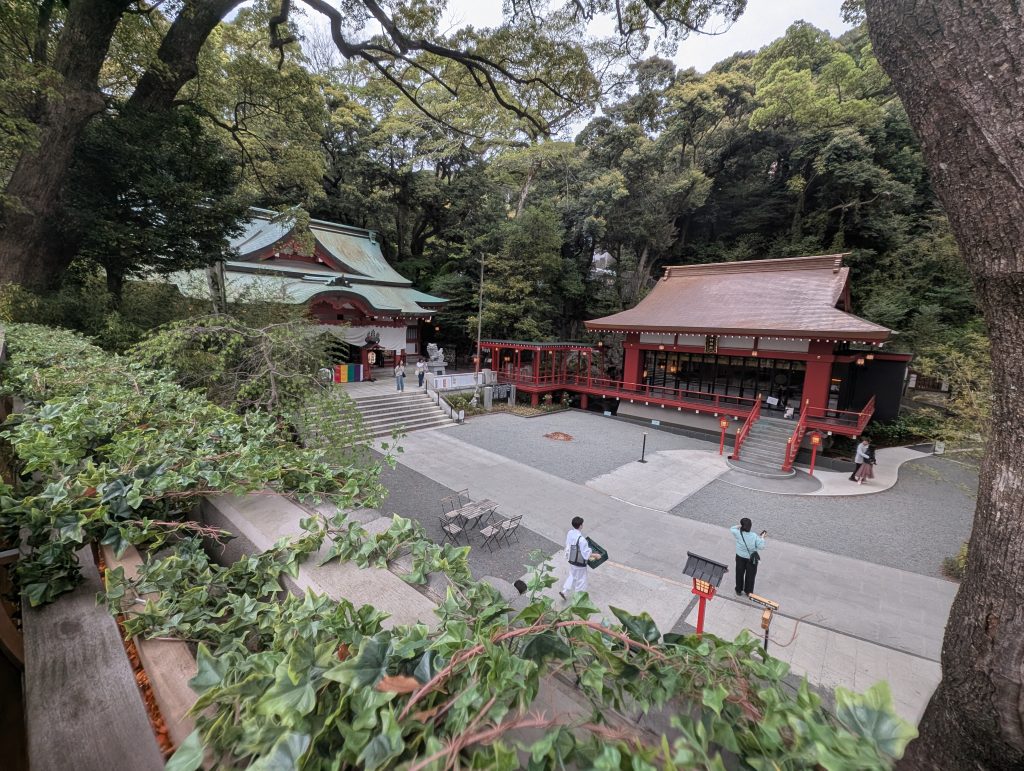







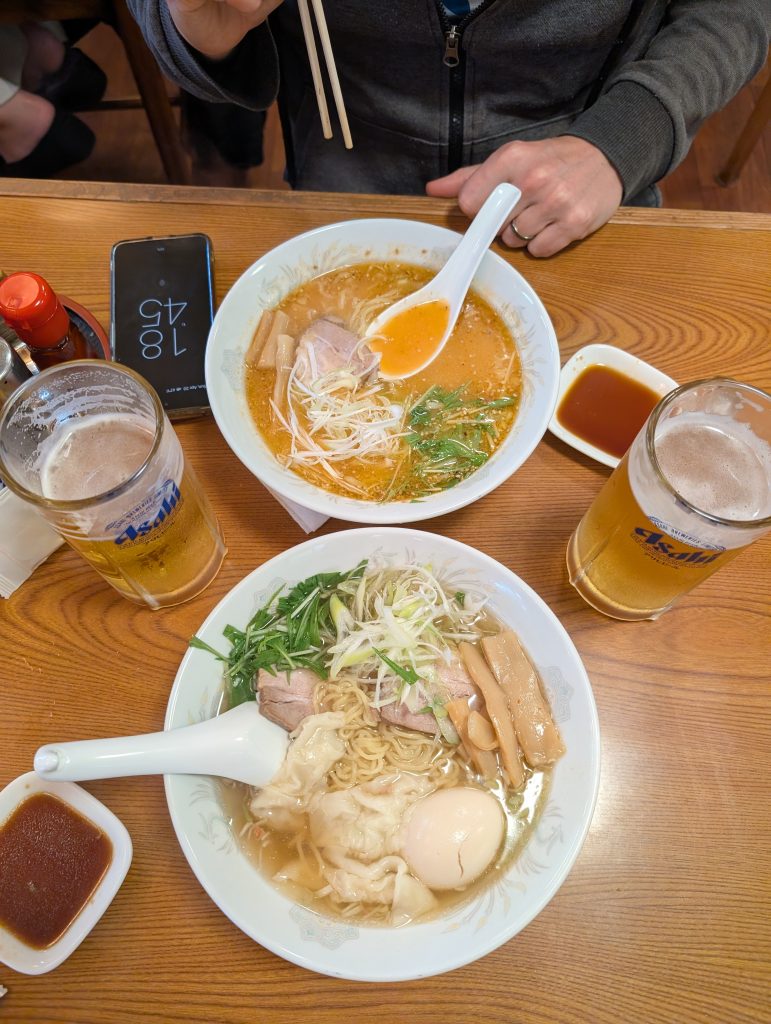
Kyoto
We took the Shinkansen to Kyoto mid-morning the next day and arrived around noon. Our time in Kyoto was also pretty chill, because we experienced many of the main temples and attractions (Iwatayama Monkey Park, Arashiyama Bamboo Forest, Philosopher’s path, Eikandō Temple, etc.) during our time in Japan in 2019. We enjoyed all those spots but didn’t feel a strong need to revisit them.
It was too early to check into our Airbnb but we were able to leave our luggage there while they finished cleaning the room and went to lunch at a nearby cafe specializing in quiche. That afternoon we settled into our three-day home and then went out in Nishiki Market that evening, which was only a short walk from our hotel. We enjoyed some crab tempura in the market and then went out for a local specialty, herring soba, in the restaurant that originated it, Sohonke Nishin-Soba Matsuba. It was tasty, as was my duck jelly ramen.
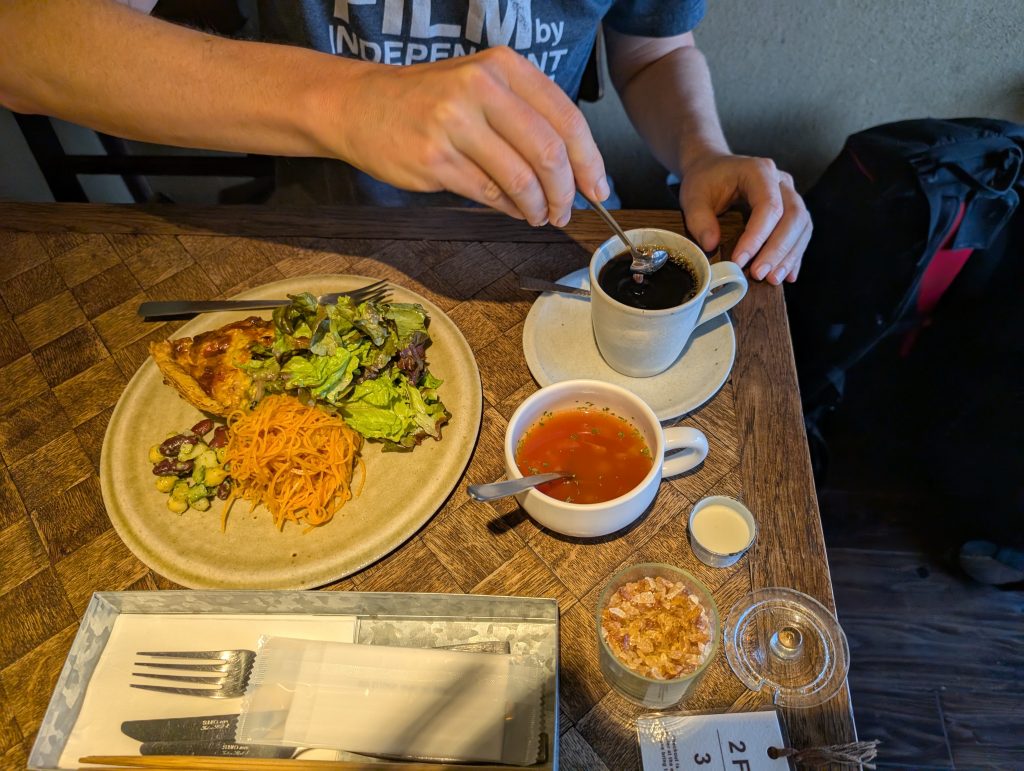




The next day, we got up as early as we could to visit Fushimi Inari, the famous shinto shrine with thousands of Taisho gates. We hadn’t visited it in 2019, perhaps because it tends to be really crowded or perhaps because it is a little away from the other attractions of Kyoto or perhaps we just prioritized other things. I’d hoped for us to arrive around 6:15 a.m. but it was closer to 7 when we got there and already fairly crowded (though not nearly as crowded as when we left at 9!). We joined the throngs in climbing up through the many gates. The higher we went, the fewer people there were and it actually was a very peaceful walk, despite all the stairs. Seeing so many gates was a really neat experience. We walked all the way up to the summit and back down. We were curious about what was written on the gates so used Google translate to find out. Turns out to be just the names of companies sponsoring them and the date. As a fundraiser, I liked that, but we’d expected it to be Shinto wisdom or something equally meaningful.















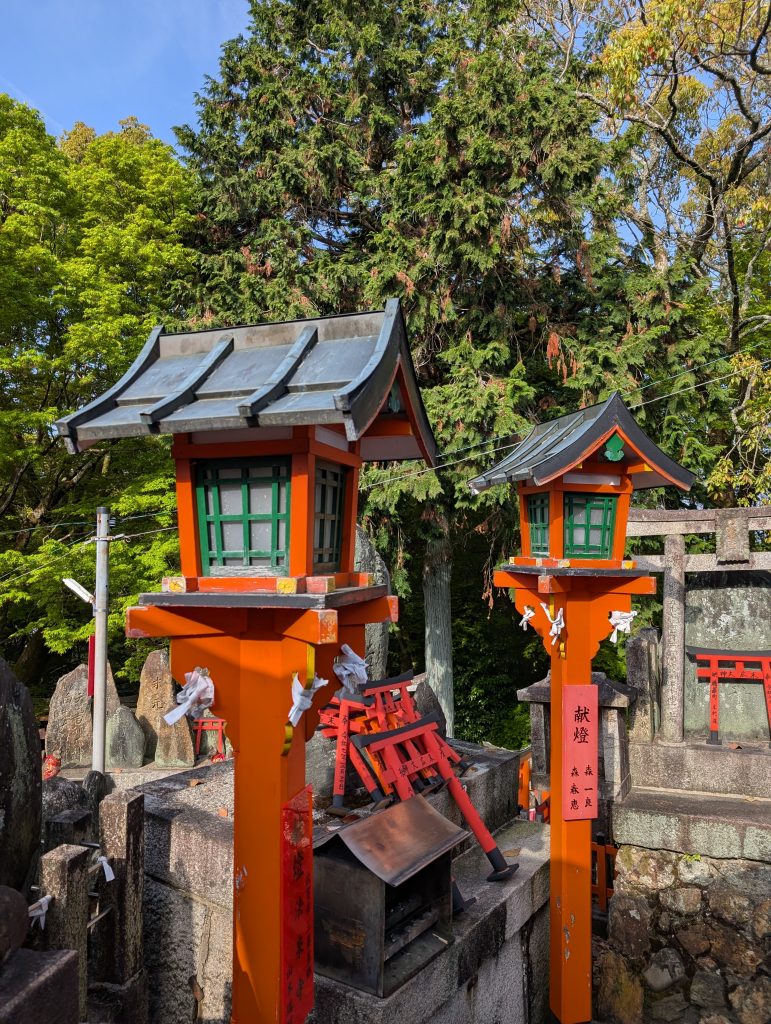
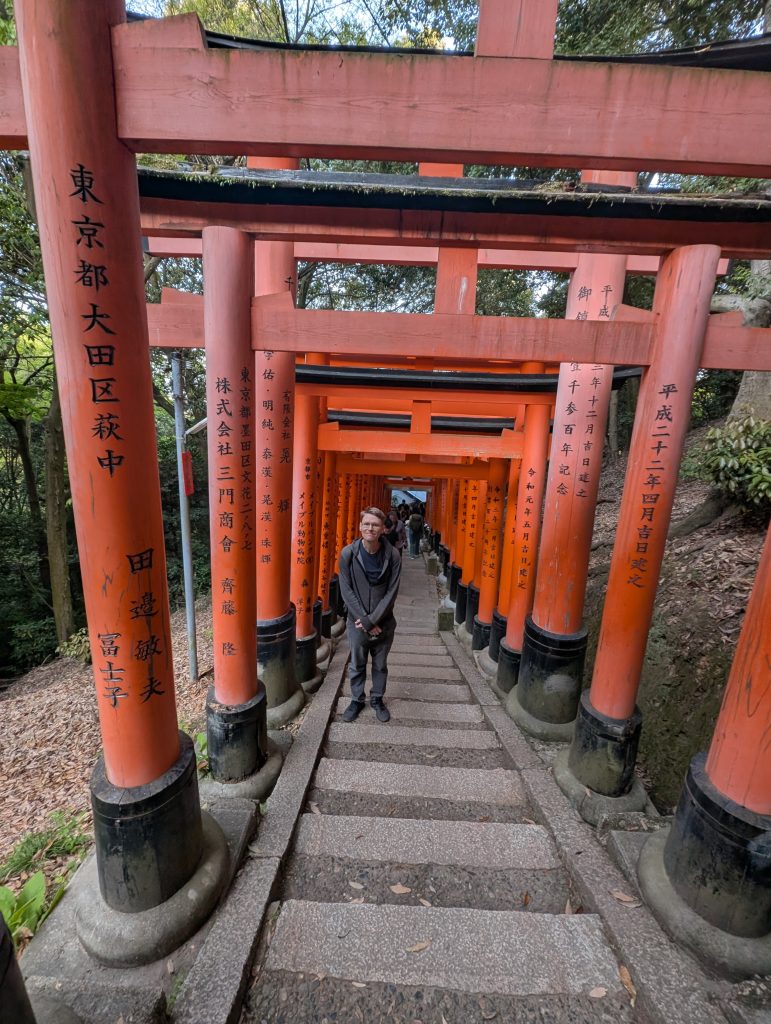




We spent the rest of the day relaxing and enjoying our neighborhood, including a lovely walk along the Kamo River. We made an easy fish dinner that night, using the stools in the apartment as tables. It was a very tiny Airbnb and while it worked for our three days, it would be impossible for a long stay.



The next day in Kyoto was a bit rainy, but we ventured out to Kyoto Gyoen National Garden and enjoyed wandering around. That night we went back through Nishiki Market and this time tried a couple of the 100 yen sake deals several of the vendors use to lure tourists in. We got some grilled eal and grilled scallops at the most inviting of the tourist places, tried a big pickle, went back for more tempura crab, and then went to a stand-up izakaya Chad had researched.
We had a very long wait to get in but it was worth it because they had several veggie options, including seaweed dipping noodles, and very good fish. They also had a sake flight and we were able to learn more about different sakes, which are differentiated by the rice polishing ratio. We tried a spectrum from 40, in which 60% of the rice was ground away so it was just the pure center and very dry, up to 100, which was made with whole brown rice and much sweeter. It was very interesting and added to our appreciation of sake. We liked the percentages on the dry end of the middle best.












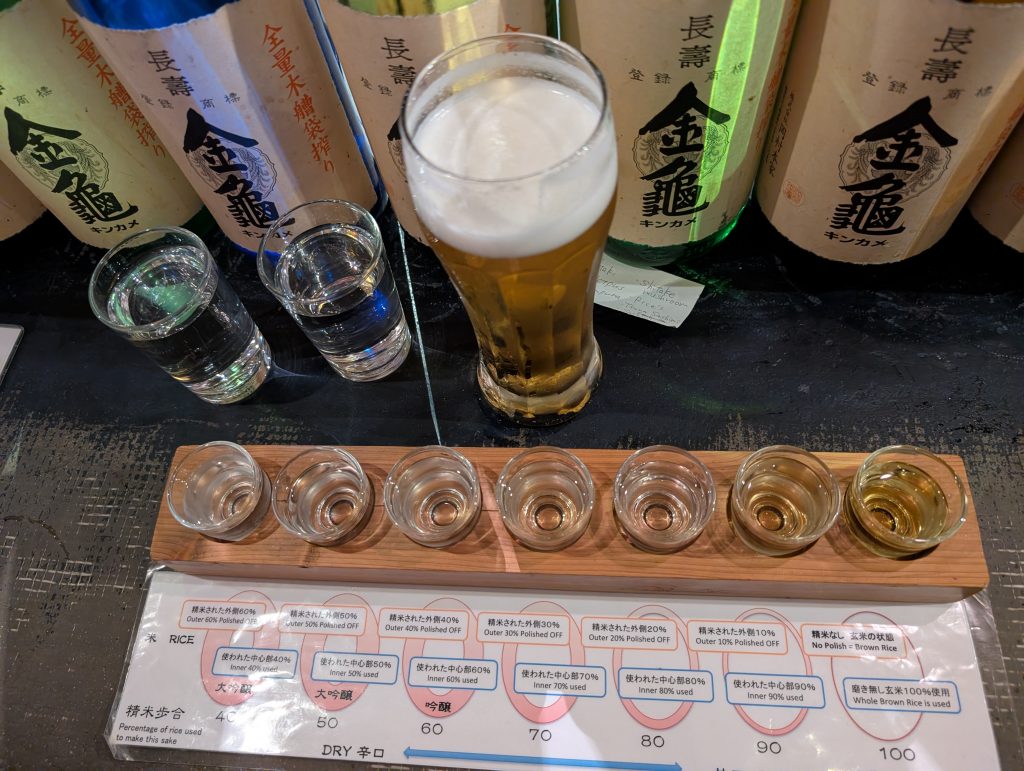


Summary
We enjoyed our time in Atami and especially Kyoto, which is a very special (though heavily-touristed) place. However, after more than a week of being tourists, we were more than ready to settle into our month-long stay in Osaka. Still, it was a great opportunity to see these places and especially to be able to enjoy Kyoto in the evening without needing to catch a train back to Osaka.
Prince Smart Inn Atami – Good place to stay near the train station – Liked · The hotel is next to the train station, which is also where our bus arrived from Hakone, so it was very convenient for us. The room was a good size. We were able to get our luggage sent there from our Tokyo hotel. They also had free lockers for storage before or after checkout, which were easy to use. Check-in was through an automated system but they had staff on hand to help navigate it. All of the staff members were very friendly and professional. Disliked · I wish the room had a kettle and cups in addition to the small fridge. The free breakfast from the cafe was interesting and probably very traditional – a grilled rice ball with a savory cake thing on top that you pour hot water over to make broth. We didn’t like it enough to get it again our second day.
Kyoto Airbnb – My husband and I stayed for three nights in this apartment and it was a great choice for our time in Kyoto. We loved the location on a quiet street that was an easy walk to public transit and the Nishiki Market. The kitchenette worked well for making very light meals. Wifi was consistent. Sugimoto communicated well and allowed us to drop off our big luggage a couple hours prior to the check in time, which we appreciated.